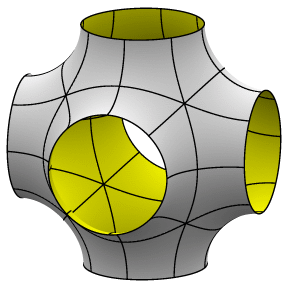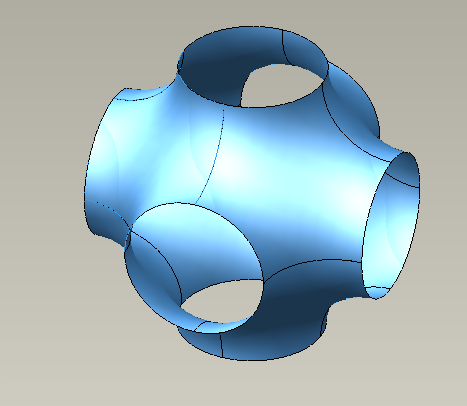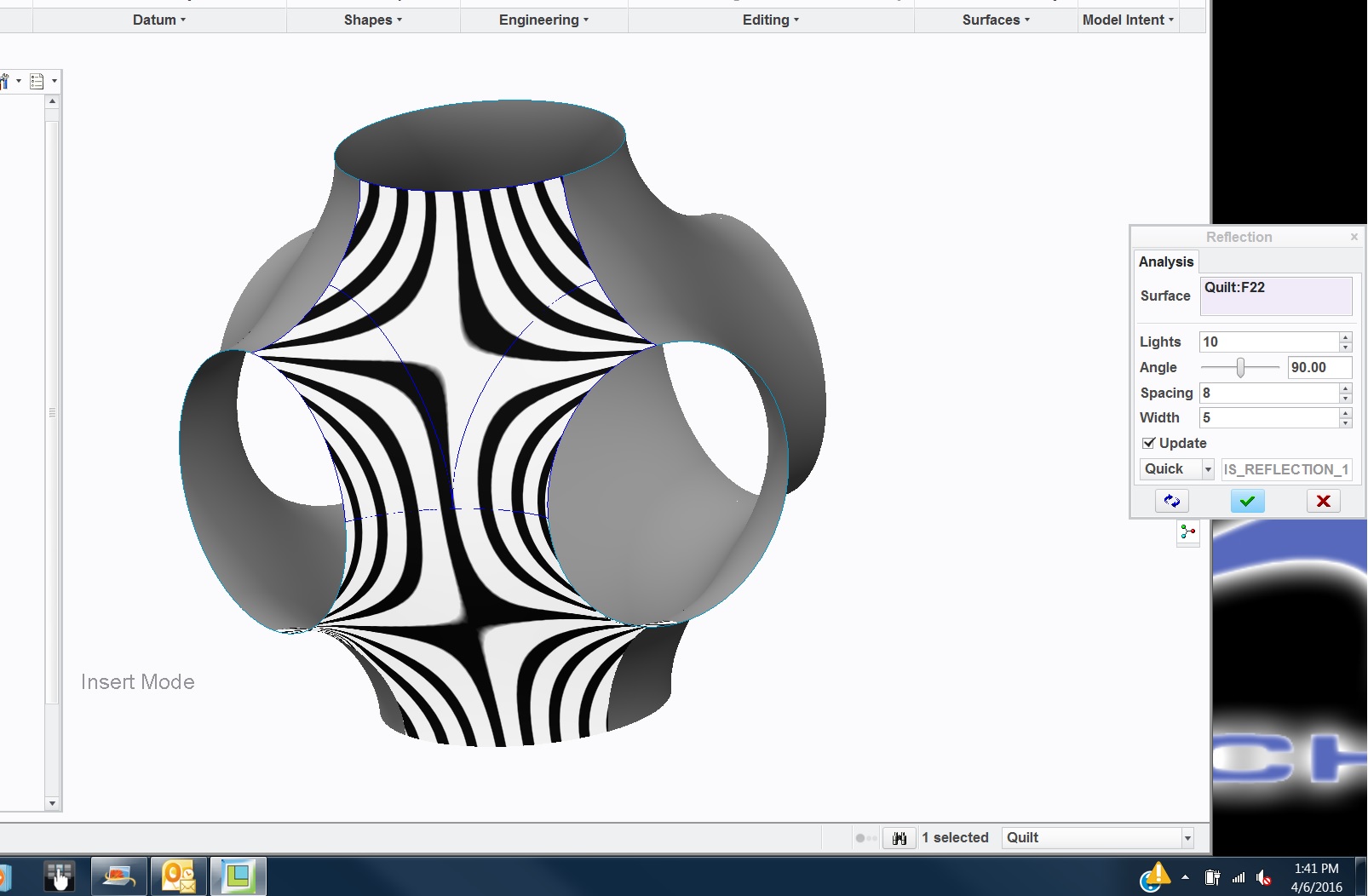- Community
- Creo (Previous to May 2018)
- Creo Modeling Questions
- Re: Does anybody know how to create this model ?
- Subscribe to RSS Feed
- Mark Topic as New
- Mark Topic as Read
- Float this Topic for Current User
- Bookmark
- Subscribe
- Mute
- Printer Friendly Page
Does anybody know how to create this model ?
- Mark as New
- Bookmark
- Subscribe
- Mute
- Subscribe to RSS Feed
- Permalink
- Notify Moderator
Does anybody know how to create this model ?
I want to create the attached model. Pls help !!
....
Mani. 
- Tags:
- surface
- Mark as New
- Bookmark
- Subscribe
- Mute
- Subscribe to RSS Feed
- Permalink
- Notify Moderator
My quick stab at it.
I used extrusions, rounds, then shelled.
I'm sure there are many other ways to tackle this, here is one.
Ron
- Mark as New
- Bookmark
- Subscribe
- Mute
- Subscribe to RSS Feed
- Permalink
- Notify Moderator
I'm going to assume you want it to be nice smooth transitions.....so, a day in ISDX or 5 minutes in T-Slpines for Rhino - a very cheap CAD program where third parties make very useful plugins - and export a STEP file to Creo.
Put t-Splines as a search into youtube and see what comes up.
I wish Creo could do it easily, I was hoping T-Splines would make a Creo plugin at some point in the last 5 years, but guess either Creo won't let them or its not financially viable as most Creo users don't care much about the surface quality.
Cheers
Stephen
- Mark as New
- Bookmark
- Subscribe
- Mute
- Subscribe to RSS Feed
- Permalink
- Notify Moderator
I used curves and the style feature to create a surface model.

- Mark as New
- Bookmark
- Subscribe
- Mute
- Subscribe to RSS Feed
- Permalink
- Notify Moderator
I would say yours is the best so far -assuming that the requirement was for circular apertures.....the middle of the surfaces are not that great though when you analise with reflections, but probably good enough for the part Mani needs. I think that is just what happens with N sided surfaces in Style / ISDX
- Mark as New
- Bookmark
- Subscribe
- Mute
- Subscribe to RSS Feed
- Permalink
- Notify Moderator
I was surprised how good it came out on the first try.
- Mark as New
- Bookmark
- Subscribe
- Mute
- Subscribe to RSS Feed
- Permalink
- Notify Moderator
If the surface quality is important, you can use the freestyle tool. However, you can find problems to set the exact diameter due the lack of control.

- Mark as New
- Bookmark
- Subscribe
- Mute
- Subscribe to RSS Feed
- Permalink
- Notify Moderator
I was thinking in this direction as well. The nice thing about Creo 3 is that you can merge the freeform to existing geometry.
This means you can manage the diameter and even the location of the join from the origin.
I have also come to trust skeletons (simple curve geometry) to guide the freeform scaling.
Keeping things symmetrical is the biggest hurdle. The scale feature is most useful.
- Mark as New
- Bookmark
- Subscribe
- Mute
- Subscribe to RSS Feed
- Permalink
- Notify Moderator
Mani, do you have the export file (step or iges) of the original? that you can attach? Use the advanced editor.
- Mark as New
- Bookmark
- Subscribe
- Mute
- Subscribe to RSS Feed
- Permalink
- Notify Moderator
No I don't have the original model. I have only pic. . !!
- Mark as New
- Bookmark
- Subscribe
- Mute
- Subscribe to RSS Feed
- Permalink
- Notify Moderator
I used the N-Sided patch tool which worked quite well, actually. I was surprised, I've not had a lt of luck with it.
I assumed that the part was symmetric but that the outlets weren't all the same diameter nor the same offset. Outlets on each axis can be changed independently and the offsets can as well. Part is pretty flexible, but the shape gets a little odd at extremes.
Creo 3 part attached.
- Mark as New
- Bookmark
- Subscribe
- Mute
- Subscribe to RSS Feed
- Permalink
- Notify Moderator
I've never had much luck with that feature either. Your's is a really nice solution.
- Mark as New
- Bookmark
- Subscribe
- Mute
- Subscribe to RSS Feed
- Permalink
- Notify Moderator
Thanks everyone !!! It help's me a lot.
- Mark as New
- Bookmark
- Subscribe
- Mute
- Subscribe to RSS Feed
- Permalink
- Notify Moderator
I started down this path too, but I couldn't get Creo to make all the individual boundary blends and make them tangent. Were you able to do so?
- Mark as New
- Bookmark
- Subscribe
- Mute
- Subscribe to RSS Feed
- Permalink
- Notify Moderator
Doug; under the tabs in the dialog, there is a place you can set the state of the edges. You get free, normal, tangent and curvature.
You can also click on the white bubble with the black dots in the graphics window. In the dialog, you can set of change the feature you want Normal, tangency, or curvature from.
And you can also assign you own connecting points. Boundary blend is simply full of little Easter eggs.
- Mark as New
- Bookmark
- Subscribe
- Mute
- Subscribe to RSS Feed
- Permalink
- Notify Moderator
I'm familiar with the controls, what I meant was that when I set them to be either tangent to the adjacent surface or normal to the plane the curve was sketched on, Creo refused to build them Some of them refused to build at all because it said the corners were not joined, even though the curves were defined as aligned to one another. Thinking about it again, I believe I was using normal to the sketch plane and that wasn't necessarily true, since I wasn't building a fully symmetric part.
Unfortunately, I didn't save that version with the additional curves. Maybe I'll go back to the one I built with the N-sided patch and try again if I have time.
- Mark as New
- Bookmark
- Subscribe
- Mute
- Subscribe to RSS Feed
- Permalink
- Notify Moderator
For what it is worth, here is my attempt at modelling the required part (done with the N-sided patch).
Regards
John
- Mark as New
- Bookmark
- Subscribe
- Mute
- Subscribe to RSS Feed
- Permalink
- Notify Moderator
Nice! I have only had to use it a couple times, but it worked excellent, if the interface is a little clunky. Your curvature looks great. I used it on my tri-y surf.
Good job!
- Mark as New
- Bookmark
- Subscribe
- Mute
- Subscribe to RSS Feed
- Permalink
- Notify Moderator
Tried creating all the curves and creating the 6 boundary blends again, Creo would not accept tangency at the central transition curves. It must be how I'm creating the transition curves, but I've got no more time to play with it right now. I've attached the model in case anyone wants to have a look.
- Mark as New
- Bookmark
- Subscribe
- Mute
- Subscribe to RSS Feed
- Permalink
- Notify Moderator
I see what you mean now Doug. Try making all that.....with one surface instead of 6. You should be able to reference parent planes as a normal reference at every curve.
HATE not being able to play with things like this..... BUT, hopefully that will get solved soon.
- Mark as New
- Bookmark
- Subscribe
- Mute
- Subscribe to RSS Feed
- Permalink
- Notify Moderator
I already built is as an N-Sided patch (see my original response above Re: Does anybody know how to create this model ?), I was responding to the Steven's suggestion (Re: Does anybody know how to create this model ?) to create all the curves and connect with boundary blends. I couldn't get it to work because the tangency couldn't be solved.
Using boundary blends, I'm not sure you can do it in fewer than 6 because of the 4 curve requirement, or am I missing something?
- Mark as New
- Bookmark
- Subscribe
- Mute
- Subscribe to RSS Feed
- Permalink
- Notify Moderator
I got the boundary blend to build and to be tangent, but it's not as nice as the N-Sided patch. I think if I played with it some more, I could make it better, but I've spent too much time on it already. The RH side & LH side in the image were built differently and the LH side came out better. I suspect duplicating that method would yield better results.
It's attached below.
- Mark as New
- Bookmark
- Subscribe
- Mute
- Subscribe to RSS Feed
- Permalink
- Notify Moderator
Looks a lot better! Without access to a system, I'm guessing. I'd try putting all 6 curves in direction 1, then use a normal constraint for the edges....if it will let you. This looks interesting, it's frustrating for me that I can;t dig into it..... ![]()
N-sided patches work great for this stuff though!
Hopefully that will change soon......
- Mark as New
- Bookmark
- Subscribe
- Mute
- Subscribe to RSS Feed
- Permalink
- Notify Moderator
Do you have any CAD available to you, Frank?
- Mark as New
- Bookmark
- Subscribe
- Mute
- Subscribe to RSS Feed
- Permalink
- Notify Moderator
Sadly, no, still jobless...... ![]()
- Mark as New
- Bookmark
- Subscribe
- Mute
- Subscribe to RSS Feed
- Permalink
- Notify Moderator

Style feature works as well.
Three sketches, one style feature then mirrors.
- Mark as New
- Bookmark
- Subscribe
- Mute
- Subscribe to RSS Feed
- Permalink
- Notify Moderator
@ Steve
Now that I've played with this method, how did you determine the diagonal section parameters.
That 3 way union radial distance isn't defined unless you start with a sphere.
- Mark as New
- Bookmark
- Subscribe
- Mute
- Subscribe to RSS Feed
- Permalink
- Notify Moderator
I'm not sure how Steven did it, but you can find my model with all the curves a couple of posts above:
- Mark as New
- Bookmark
- Subscribe
- Mute
- Subscribe to RSS Feed
- Permalink
- Notify Moderator
The N-Sided surface is very nice when defining the periphery as one surface.
That section through the diagonal can be defined in many different ways but in general, it becomes a very critical junction - IF - you're going to try to define it.
I am not sure if Steve did define this and if so, using what type of feature.
Technically, I would try to specify the spherical radius for the 8 "points" of intersection. However, it is very easy to define a really crummy surface regardless of tangency or continuity.

